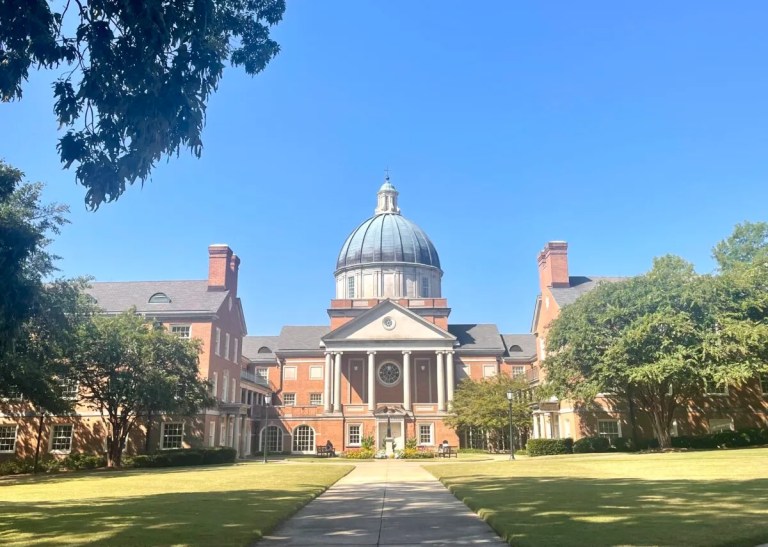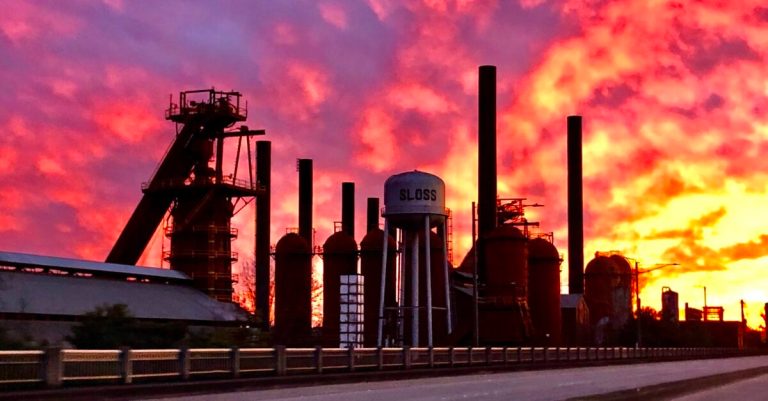Why Should You Care about the I-59/20 Debate? Birmingham’s Future is at Stake (Part 1 of 3)
Reading time: 7 minutes
Sponsored
By: Cary Estes

It is difficult to bridge economic and social gaps when there is an actual bridge standing in the way. That is the situation Birmingham has been facing for nearly a half-century, ever since Interstate 20/59 was completed near the northern edge of downtown, creating a concrete-and-steel barrier between the central business district, the Birmingham–Jefferson Convention Complex and the nearby neighborhoods of Druid Hills, Fountain Heights, and Norwood.
While people in cars can easily travel from one side to the other by driving underneath the 1.3-mile elevated section of highway, it is a much more daunting task for pedestrians. In addition, the looming structure also generates a psychological impediment, creating distinctly different areas on both sides of the roadway.
As a result, while the city center and points south have been thriving in recent years, the predominantly African-American neighborhoods just to the north of I-20/59 continue to struggle with poverty and urban blight.

That is what makes the current issue of the replacement of that section of I-20/59 so important to the long-term future of Birmingham. There is general agreement that something must be done to the structure, which was completed in 1971 and currently handles double the amount of daily vehicle traffic as originally intended. The situation became a true safety issue in 2013 when chunks of concrete fell from the bridge, damaging parked cars below and creating a hole in the pavement. This led to the announcement a year later that public parking no longer would be allowed under the viaduct, resulting in acres of basically wasted space.

The dispute is over what type of structure the new roadway should be, and even where it should be located. The Alabama Department of Transportation (ALDOT) proposes replacing the existing structure with a bridge that ALDOT officials say will be wider and safer, partly by eliminating most of the access ramps that can cause traffic congestion and accidents. However, several local business and citizens groups want to use this opportunity to remove the barrier by either dropping the interstate below ground level – allowing for downtown streets, pedestrians walkways, commercial buildings and greenspaces to be built on top – or to reroute the roadway entirely a few miles to the north.
“There is nothing in Birmingham that could be as transformative as this. Nothing,” local business leader Temple Tutwiler III with Tutwiler Investments said recently. “It’s a chance to sew the city back together.”
The divide was originally created as a result of the federal government’s mandate following World War II that all U.S. cities with populations greater than 100,000 be connected to the Interstate Highway System, a project that took decades to complete. When the section of I-20/59 was being built through Birmingham, the possible routes were limited by the presence of the Birmingham airport, a large cemetery and several neighborhoods. Those obstacles still exist, which complicates any effort to reroute the interstate from its current location.
In the early 2000s, Birmingham city officials began to seriously consider how to replace the structure and reconnect the communities north of the elevated roadway to the city center. Lowering the roadway was part of the Urban Design Associates’ 2004 update of the Birmingham City master plan, which was endorsed by Operation New Birmingham (now REV Birmingham) and the Regional Planning Commission of Greater Birmingham.
Then in 2009, engineering and design firm Parsons Brinckerhoff – which was founded in 1885 and has offices in nearly 40 countries – was commissioned to conduct a study on whether lowering the roadway was indeed feasible from an engineering and design perspective. The company concluded that such a project was possible, and that it would cost nearly $700 million and take three years to complete, during which time the corridor would remain open to traffic. Additionally, the company stated that such a project would result in long-term economic benefits for the city.
But the wheels of government often turn slowly, and in this case, apparently didn’t turn at all. Further studies were done, but the plan never gained any significant traction. Then in 2012 the Alabama Department of Transportation announced that it was moving forward with a repair project of the existing structure, declaring that the proposal to lower the interstate was too expensive.
ALDOT’s original plan was only to repair the aging bridge decks atop the existing foundation at a cost of approximately $125 million. But city and county officials asked ALDOT to consider other options – including re-decking the bridge with concrete decks rather than steel undergirded decks – in order to improve safety and aesthetic issues. ALDOT replied that such a change would result in a significantly heavier structure that would require replacement of some of the substructure.

At this point the conversation shifted toward a total replacement of the structure. That led to ALDOT’s current plan for the construction of an elevated 10-lane highway – an increase from the current six lanes – and the removal of all but one of the access ramps between 15th Street and 31st Street North. The open space that currently exists between the eastbound and westbound lanes will be filled in and the entire structure widened.

ALDOT originally estimated that the project – which has already started and will be conducted in three phases – will take four years to complete and cost approximately $450 million. Local groups contend the final total will likely exceed $600 million, and might even get close to the $700-million original estimate of how much it would cost to lower the roadway. These groups also state that ALDOT has been unwilling to truly consider other options, and that a once-in-a-generation opportunity to revitalize part of the city is being lost.

As a result, a group of local leaders – including Birmingham City Council President Johnathan Austin, Birmingham Board of Education President Randall Woodfin and Darrell O’Quinn, the executive director of the Move I-20/59 organization – filed a lawsuit in U.S. District Court last October seeking to halt the work and order ALDOT to take a “hard look” at alternatives. In June ALDOT asked for the lawsuit to be dismissed, a motion that has not yet been ruled upon.
ALDOT ran a full-page ad in several publications earlier this year stating that the agency “does not believe it is possible to re-route or bury the interstate.” And in an editorial piece for al.com in January, ALDOT director John Cooper wrote that he believes the current replacement plan is the only viable option.
“As ALDOT director, I have been personally involved with this project for more than four years,” Cooper stated in the editorial. “I also lived in the Birmingham area for two decades, and remain a frequent user of I-59/20. My deep understanding of the project leaves me convinced that the plan to replace and improve the bridges is not only the best option, it is the only viable solution from among many that have been considered.”
One of the reasons for this conflict is the objectives of ALDOT are not the same as that of local government officials and civic groups. ALDOT’s primary responsibility is to enable vehicular traffic to move as safely, conveniently and inexpensively as possible. Those opposed to the ALDOT plan also want the highway to be economical, safe and convenient, but in addition they are focused on quality of life and the ability to promote development. So far, it seems there hasn’t been a way to bridge the gap between these two points of view.
Our second part of the I 20/59 series shares information and points of view from local constituents in favor of ADOT making a serious evaluation of alternative options.
Part 3 shows what I20/59 could look like and shares examples from Atlanta and Dallas.
Have comments or questions? We’d love to hear from you at hello(at)bhamnow.



